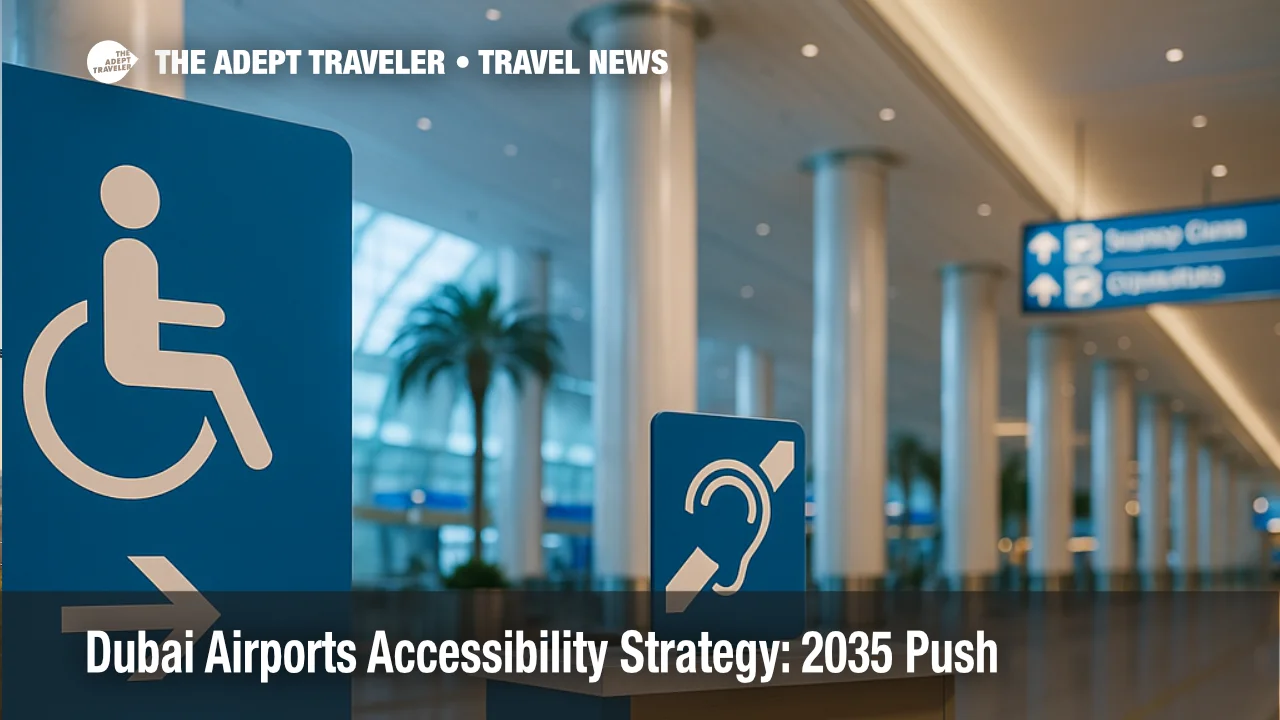Dubai Airports accessibility strategy: 2035 push

Dubai Airports has launched the next phase of its accessibility strategy, a renewed 10-year commitment to make Dubai International Airport (DXB) and Dubai World Central - Al Maktoum International (DWC) the world's most accessible, inclusive airports by 2035. The plan centers on stronger foundations, end-to-end guest-journey upgrades, and a culture shift built with and for People of Determination. A new "DXB for All" campaign, co-created with advocates, spotlights lived experiences and encourages empathy across the oneDXB community. Partners include Emirates, flydubai, airport authorities, and key government agencies.
Key points
- Why it matters: Better access improves dignity, speed, and independence for millions of travelers.
- Travel impact: More priority lanes, sensory-friendly routes, and consistent assistance at DXB and DWC.
- What's next: Rollout of training and services aligned to global best practices through 2035.
- Scale: 520+ hearing-loop touchpoints now operating across terminals.
- New tools: Travel Planner, Sunflower Lanyard access, and an Assisted Travel Lounge at T2.
- Co-creation: Campaign built with People of Determination and oneDXB partners.
Snapshot
Dubai Airports' updated roadmap aims to move beyond infrastructure and into mindset, embedding inclusive design and service across every touchpoint. The "DXB for All" campaign tells six stories from travelers with different needs, from a child with sensory sensitivities to a deaf guest supported by staff using sign language. Current services include a hidden-disabilities Sunflower Lanyard program with priority routing, an online Travel Planner, complimentary two-hour parking, dedicated taxis, wheelchair support, and a quiet, sensory-friendly Assisted Travel Lounge in Terminal 2. More than 520 hearing loops have been installed across DXB to support guests with hearing aids. Dubai's broader goal is to be a disability-friendly city, with DXB and DWC positioned as global leaders in inclusive travel.
Background
DXB handled record traffic in 2025, while laying groundwork for an eventual scale-up at DWC. To ensure growth does not leave accessibility behind, Dubai Airports began a multi-year inclusion journey in 2022 with "We All Meet the World Differently," initially focusing on autism and hidden disabilities. Since then, the operator has expanded services and training, earning recognition for hearing-loop deployment and standing up new guest-assistance spaces. The operator also established an advisory group of accessibility advocates to identify gaps and hold teams accountable. The refreshed plan through 2035 formalizes that co-creation approach, aligning with international best practice and the UAE's commitment to the rights of People of Determination. The oneDXB coalition brings airlines, security, immigration, customs, ground handlers, and retail together to deliver consistent support.
Latest developments
'DXB for All' campaign powers the next phase of inclusive travel
The new "DXB for All" campaign anchors Dubai Airports' 10-year pledge, using real traveler journeys to highlight what inclusive service looks like at a mega-hub. Featured advocates include Emirati accessibility leader Fatma Al Jassim, inclusion consultant and former Paralympian Jessica Smith, and Dubai-based families and travelers representing deaf, visually impaired, autistic, ADHD, and mobility-aid communities. Operationally, the program builds on existing tools: Sunflower Lanyard identification with access to priority lanes and an autism-friendly route; a pre-trip Travel Planner that demystifies each step; 520+ hearing-loop touchpoints for clearer audio; and a sensory-friendly Assisted Travel Lounge at Terminal 2 that offers a low-stimulus space. Delivery depends on whole-community execution, with partners such as Emirates, flydubai, Dubai Police, immigration, customs, dnata, ambulance services, taxi, health, duty-free, and facilities providers coordinating to keep assistance consistent from curb to gate.
Analysis
Aspirations to be "most accessible" are only credible when backed by measurable, system-wide changes. Dubai Airports' approach checks several boxes that often derail accessibility efforts at major hubs. First, co-design with People of Determination reduces the risk of performative campaigns and surfaces friction that only lived experience reveals, such as signage legibility, audio clarity, or lighting that can overwhelm those with sensory sensitivities. Second, the 520-plus hearing-loop network and the Assisted Travel Lounge address high-impact pain points immediately, while training and the Sunflower Lanyard create recognizable, repeatable patterns for staff and guests. Third, the oneDXB framework matters. Accessibility fails when airlines, security, immigration, and ground handlers operate to different standards. By aligning all partners to shared protocols, DXB and DWC can deliver predictability, which is the heart of inclusive travel. The remaining challenge is consistency at scale as passenger volumes grow and as more operations migrate to DWC. Success will hinge on ongoing audits, traveler-reported metrics, and transparent targets through 2035.
Final thoughts
For travelers, these upgrades mean less guesswork and more autonomy during stressful airport moments. For airport teams, they also clarify roles, from check-in to boarding, to keep service consistent for visible and hidden needs alike. As DWC expands and DXB remains among the world's busiest hubs, building accessibility into daily routines will be the difference between a headline and a habit. If Dubai Airports sustains co-creation, measurement, and training across partners, the 2035 goal can be more than an ambition. It can be a model others emulate, and a win for every guest touched by the Dubai Airports accessibility strategy.
Sources
- Dubai Airports launches next phase of accessibility strategy, Dubai Media Office
- Hidden disabilities program and Sunflower Lanyard, Dubai Airports
- Dubai Airports strengthens accessibility mission with new advisory voices, Dubai Airports Media Center
- DXB, DWC aim to be 'world's most inclusive' airports by 2035, Khaleej Times
- Dubai Airports sets 2035 vision for fully accessible terminals, Gulf News
- Accessibility case study: 'We All Meet the World Differently' (2022), Airports Council International PDF
